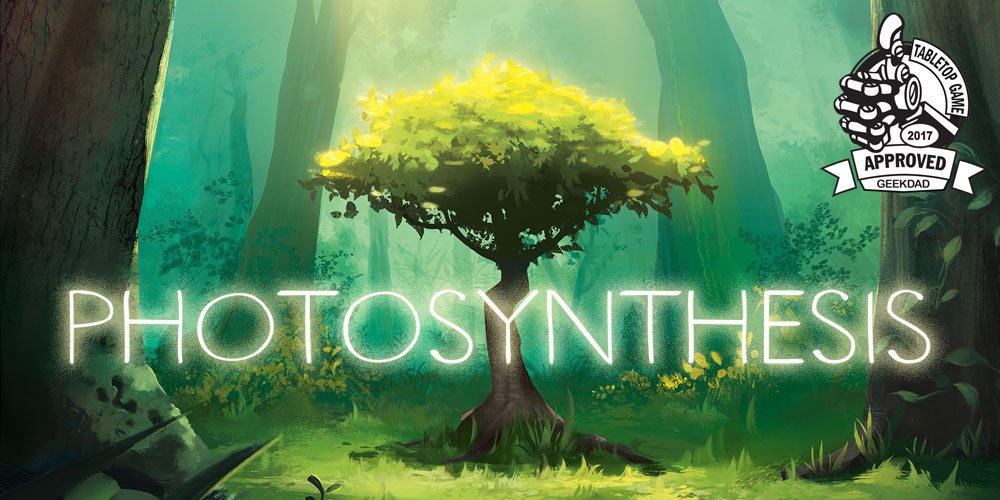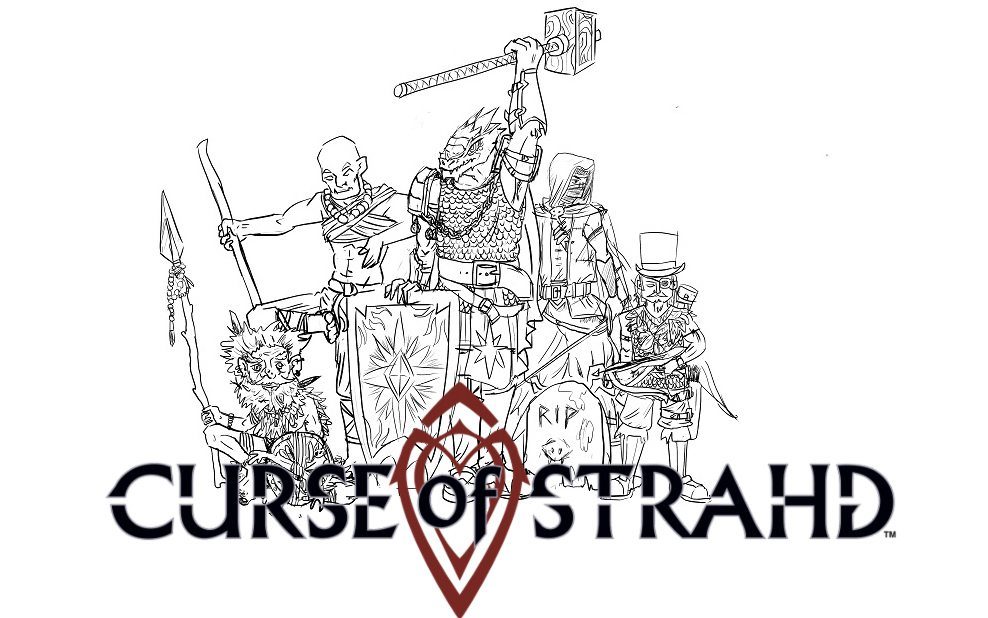As a tree, you’re focused on just a few things: get light, grow tall, make more trees. In Photosynthesis, you try to collect light and spread your seeds to the richest soil, ensuring the future of your seedlings.
What Is Photosynthesis?
Photosynthesis is a strategy game by Hjalmar Hach about growing trees. It’s for 2 to 4 players, ages 8 and up, and takes 30–60 minutes to play. It released at Gen Con this year, with a retail price of $39.99—though it might be hard to obtain for now because it sold out at Gen Con. Amazon currently has it for $59.99; Blue Orange is taking pre-orders and expects to ship at the end of September. The game is pure strategy, no luck, with a combination of resource management and territory control; there’s nothing inappropriate in its theme for younger kids, but will be best with kids who like chess-like strategy.
Photosynthesis is GeekDad Approved!

Photosynthesis Components
I was lucky enough to get an advance copy of Photosynthesis ahead of its Gen Con release, so I was able to learn it and teach it at our Game with GeekDad event. The components were mostly final, though the cardboard insert was not quite the right size—more on that later.
Photosynthesis includes:
- Game board
- Sun Segment
- 4 Sun Revolution counters
- First Player token
- 24 Scoring tokens
- 4 sets of player components, each containing:
- Player board
- Light Point tracker
- 6 Seed tokens
- 8 Small Trees
- 4 Medium Trees
- 2 Large Trees
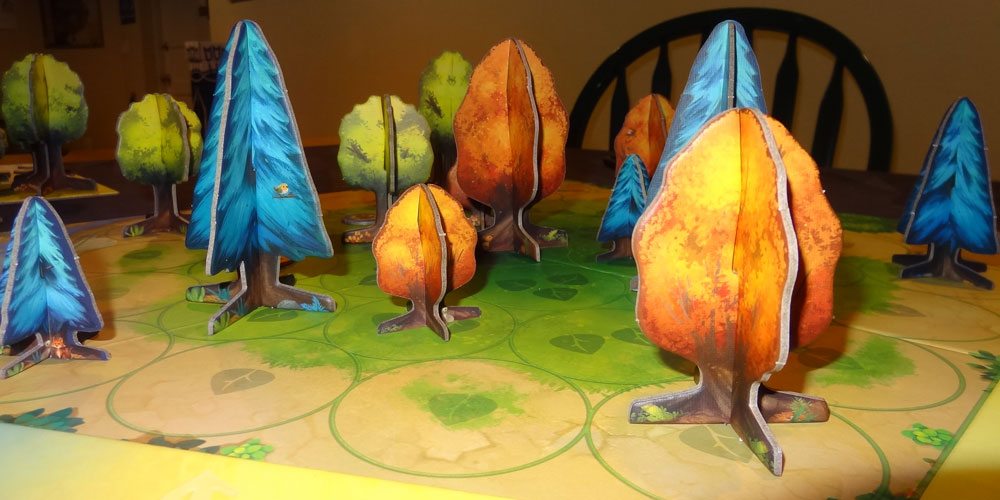
The short summary is: Photosynthesis looks beautiful, inside and out. The box cover art is gorgeous, with some spot gloss to highlight the top of the tree that’s lit up. The little cardboard trees inside are fantastic, with some little details like squirrels and birds on some of the trees. The illustrations are by Sabrina Miramon, and she did a great job with it. The player boards each depict a different variety of tree, which are distinguished not only by color but also by shape. I particularly love the way a 4-player game fills the board with different colors.
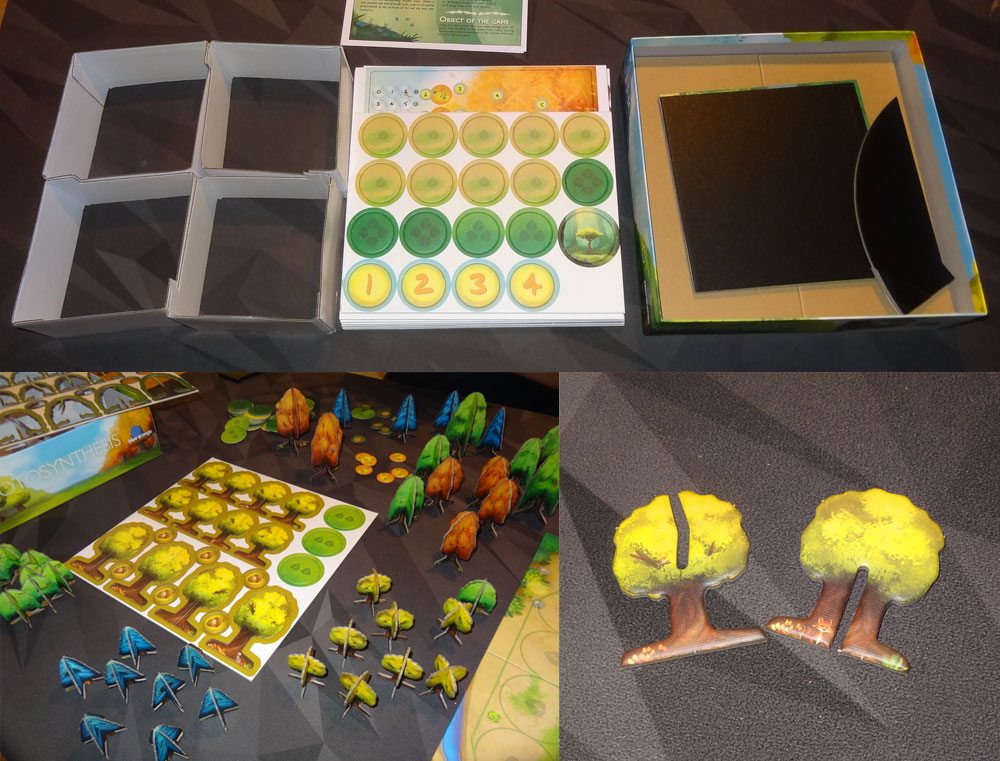
There is some assembly required: before you can play, you’ll need to punch out all of those trees and seeds, and then slot together the trees. I found that the blue trees, with the narrower tips, were more likely to slip apart, and I used some glue on a few of them.
I do like the storage solution: when you first open the box, there are four collapsed cardboard squares—after you throw away the punchboard, the four squares unfold and fill the box so that you can store all the trees (separated by player color, of course). There’s a recessed section on top to hold the game board and player boards. (My early copy wasn’t quite cut right so the player boards didn’t fit, but the finished copy works properly.) Once the trees are assembled, the contents easily fill up the box.

My only minor complaints about the insert are that the medium and tall trees are too big to stand upright in the box, so you’ll need to put them in lying down, and that there’s no particular place to put the scoring tokens, so I usually just divvy them up among the four spaces. You may want to get some small plastic bags for the seeds, light point trackers, and scoring tokens, just to keep them from getting scattered in the box.
There were a couple of things that were a little strange to me in terms of user interface: the actual playing area of the game is hexagonal, but the board is a square. I think that makes it easy to miss the fact that when the sun segment goes around the board, there are six places for it, not four. A hexagonal board would have made it easier to keep that rule straight. Also, on the player boards, there are some small green numbers indicating score values for having leftover light points—you get 1 point per 3 light at the end of the game. However, the light point track starts at 0, and there are score markers every 3 spaces, which makes it look like you get 1 point for having 0–2 light points, rather than 3–5. (UPDATE: I’ve been informed that a new board will have a corrected layout for light points.)
Those quibbles aside, I’m very pleased with the components in Photosynthesis.
How to Play Photosynthesis
The Goal
Score points by taking your trees through their entire life cycle; the better the soil, the more points you will score at the end of the tree’s life.
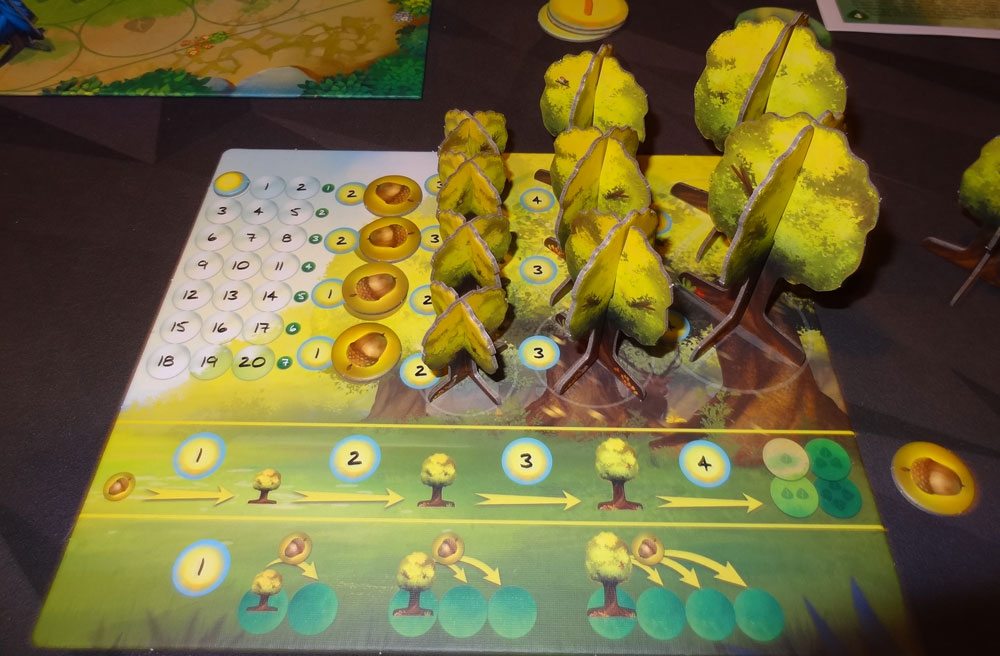
Setup
Give each player a player board and all the components of their color, along with a light tracker token. Place seeds and trees on the player board until it is filled—the leftover pieces (2 seeds, 4 small trees, 1 medium tree) form the player’s available supply.
The youngest (or least experienced) player starts and gets the first player token. The sun segment starts on the corner where there is a small (fairly subtle) sun symbol printed on the board. Starting with the first player, each player will place a small tree on the board on the outermost ring, and then take turns to place a second small tree.
The scoring tokens should be sorted by type (based on the number of leaves) and arranged so that the highest scores are on top. (Note: in a 2-player game, the 4-leaf scoring tokens are omitted.) The sun revolution counters are used to keep track of how many rounds have been played—a standard game uses 3 rounds, and an advanced game uses 4 rounds.
Round Order
Each round consists of two phases: Photosynthesis (for all players at once), and then Life Cycle (in turn order).

Photosynthesis Phase
During the Photosynthesis phase, you collect light points from your trees on the board. Small trees gain 1 light point, medium trees gain 2 light points, and large trees gain 3 light points. But wait—it’s not that simple! Trees also cast shadows, and the taller the tree, the longer the shadow. The light shines from the sun segment in straight lines along the board. If there is a tree between your tree and the sun, it may be blocked.
Small trees cast a shadow 1 space long; medium trees cast a shadow 2 spaces long; tall trees cast a shadow 3 spaces long. If your tree is in a space that has a shadow cast onto it, you will not score any light points for that tree, unless it is taller than the tree casting the shadow. (In that case, it receives its full light points.) Note that the sun segment will rotate around the board as you play, changing the patterns of light and shadow.
Move your light point tracker to indicate how many light points you received. (Unspent light points carry over from round to round.)
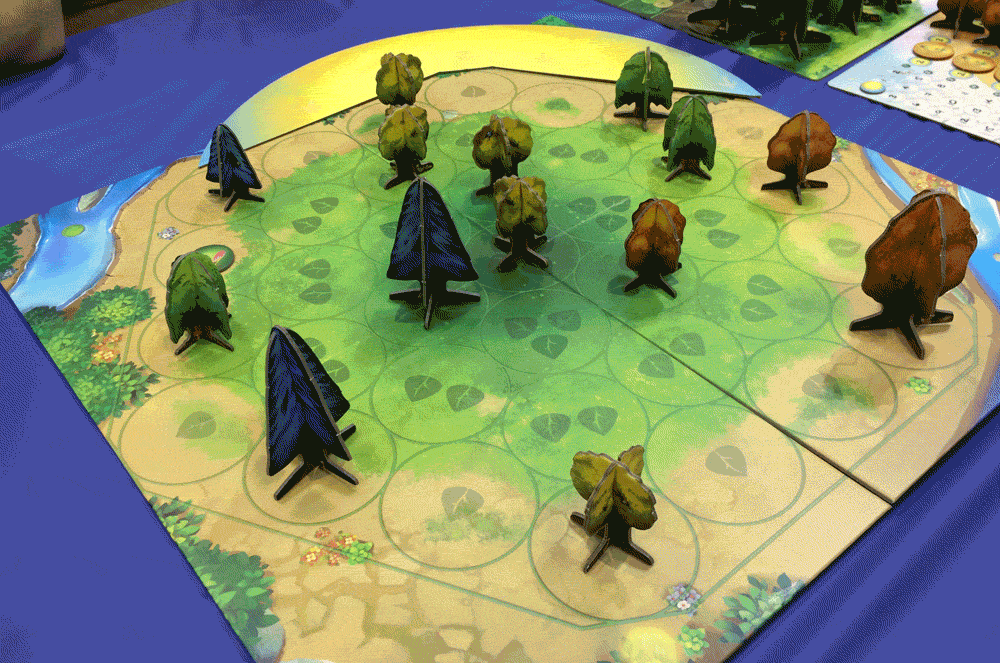
Life Cycle Phase
In turn order, each player takes as many actions as they wish and can afford. You may never carry out more than one action on the same space on the main board or on the same tree on the board. For instance, you can’t plant a seed and then immediately grow it.
Buy: spend light points to purchase seeds or trees from your player board, putting them into your available supply (next to the board). The prices are marked on the board, and as you buy more of the same thing, the price increases.
Plant a seed: Spend 1 light point to plant a seed around one of your trees—the taller the tree, the further away you can plant the seed.
Grow a tree: Spend light points to grow from seed to small tree (1 point) to medium tree (2 points) to large tree (3 points). Whenever you remove something from the main board (like when a small tree grows into a medium tree), you place it onto your player board, if there is room. If there isn’t, the piece is returned to the box and is unavailable for the rest of the game.
Collect points: Spend 4 light points to end the life cycle of a large tree—remove it from the board and then collect a scoring token corresponding to the soil type. (If there are no more of that type, take the top token from the next pile down.)

Round End
The round ends when the sun has completed an entire revolution. Discard the top sun revolution counter to indicate that the next round has begun.
Game End
The game ends after the final revolution. Players add up their scoring tokens, and also get 1 point for every 3 unused light points (round down). The highest score wins, with ties going to the player with the most seeds and trees on the main board.
For an advanced variant, you can play 4 revolutions instead of 3. You can also introduce a rule that you cannot plant a seed or grow a tree when that seed or tree is in shadow—making it particularly important to plan out where you will plant and grow each turn. You can use either or both of these rules to add a little more strategic depth to the game.
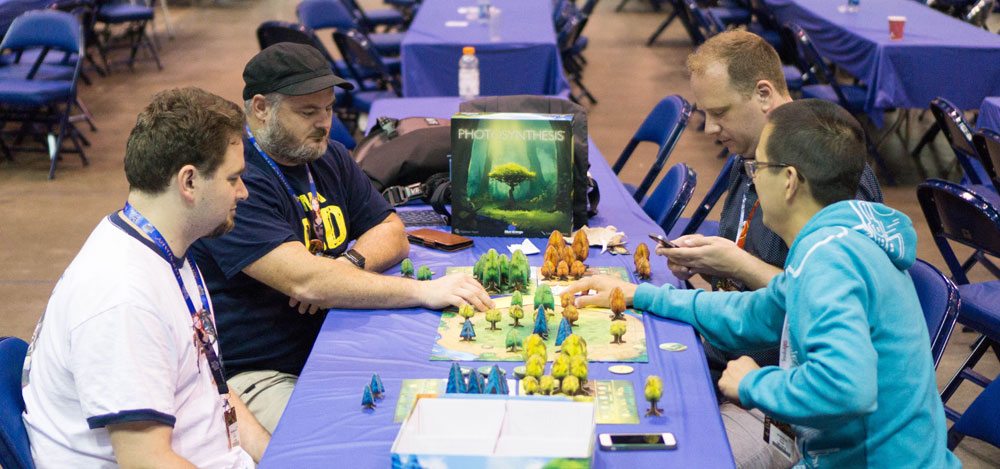
Why You Should Play Photosynthesis
Blue Orange Games has been around since 2000, starting with Gobblet, their twist on tic-tac-toe. Since then, they’ve published a lot of great kids’ games, and a few years ago started their Europe Collection, introducing more Euro-style strategy games to the mix and showing gamers that Blue Orange wasn’t just for kids. That effort has paid off, with Kingdomino winning the Spiel des Jahres this year. While Photosynthesis isn’t listed in the Europe Collection, it’s definitely a game that can be played both by kids and adults, and its popularity at this year’s Gen Con is no surprise: it’s a beautiful-looking game with deep, meaningful gameplay. A few of the GeekDads mentioned it in our Gen Con Wrap-Up as one of their favorites (though we do have at least one dissenting opinion, which I’ll get to).
I’ve already said that the game looks great on the table. If you set it up and start playing in public, I guarantee people will come over to watch. It’s always great to find games with themes that haven’t been overdone. Sure, I like fighting zombies and casting spells, but Photosynthesis stands out from the crowd, much like the tree on the front cover. You can’t help but admire it.
Those looks are backed up with solid gameplay. The rules aren’t too complex (though you’ll want to pay attention to the rule about not using the same tree or space twice, because it can be easy to forget). But once you start playing, you start to realize that it’s a pure strategy game that requires some serious thought. There’s no luck involved, and no hidden information. Everything is right out there on the table, and everything is based on decisions that you and your opponents make. You know where the sun will be on the next turn, how many light points it will cost to take an action, and where your opponents can plant trees to block your access to precious sunlight.
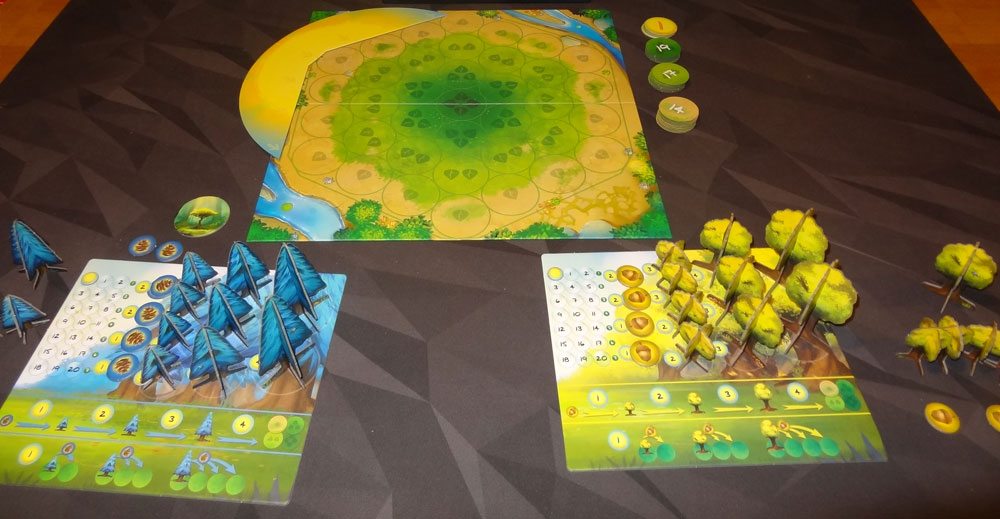
Each turn, you will have to make tough decisions about whether to grow a tree or plant a new seed, buy a tree to put in your supply or save light points for the upcoming round. When you grow a tree, you’ll have to put the replaced piece on your player board—but when you don’t have space, that piece goes away for the rest of the game. You can spend light points to buy pieces and make space on your board, but then you might not have enough left to grow the tree; it’s another hard choice you’ll probably make several times. If you get rid of a lot of pieces early, then it starts getting very expensive to buy them later.
Another tricky decision is knowing when to let your tall trees die. The tall trees are very valuable on the board—not only do they collect 3 light points each round, but they cast very long shadows and are hard to block. But you only get two of them at a time, and the only way to score is to let them die, making it possible for your other trees to reach their potential. Score them too quickly, and you won’t make back the investment of light points you spent to grow them. Wait too long, and you won’t be able to score more than two trees before the game ends.
Now, I will mention that not everyone enjoys the game: if you need a bit of luck or randomness in a game, Photosynthesis is probably not for you. There are no dice, no cards, no random events (though I can picture expansions with forest fires and lumberjacks). If you really want explosions and battles and excitement, I have to admit that Photosynthesis doesn’t really scratch that itch. It’s a contemplative game, watching trees grow and pollinate and die.
If, however, you’re looking for a game that rewards long-term planning with a unique theme, I highly recommend Photosynthesis. Look for it in stores by the end of September, or pre-order from Blue Orange now.
Click here to see all our tabletop game reviews.
Disclosure: GeekDad received a copy of this game for review purposes.
